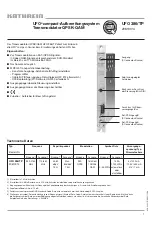
WP 34S Owner‘s Manual
Edition 2.2
Page 23 of 103
COMPARING AND ADDRESSING COMPLEX NUMBERS
1 User input
or
,
, or
Dot matrix
display
OP _
(with temporary alpha mode set)
e.g.
OP _
(with temporary alpha mode set)
e.g.
10
2
User input
or
Stack level or
named register
,
,
,
,
, or
11
leaves temp.
alpha mode
opens indirect
addressing.
Stack level or
named register
12
,
,
,
, or
Register number
..
13
opens indirect
addressing.
Dot matrix
display
OP
n
e.g.
OP
x
e.g.
OP r_
OP
_
OP
x
e.g.
OP
nn
e.g.
OP
_
3 User input
Compares
x
+
i
y
with the real
number
0
.
Compares
x
+
i
y
with
z
+
i
t
.
Register number
…
Look right for
more about indi-
rect addressing.
This is
C
LASTx.
Stack level or
named register
,
, ... ,
Register number
…
Dot matrix
display
OP r
nn
e.g.
OP
x
e.g.
OP
nn
e.g.
Compares
x
+
i
y
with
r26
+
i
r27
.
Swaps
x
with the contents of the
register where
Z
is pointing to,
and
y
with the contents of
the next one.
Stores
x
+
i
y
into
2 consecutive reg-
isters, starting with
the one where
R45
is pointing to.
10
For
and
, any of
,
,
, or
may precede step 2. See the index of operations.
11
You may skip this keystroke for register numbers >19.
12
Exceptions:
C
RCL Z,
C
RCL + Z,
C
STO Z, and
C
STO + Z require an
preceding
, e.g.
for the latter.
13
You may key in e.g.
instead of
. Take care of pairs, since a complex operation will always affect two registers: the one specified and the
one following this. We strongly recommend storing complex numbers with their real parts at even register numbers.
– Please take into account some registers
may be allocated to special applications.















































